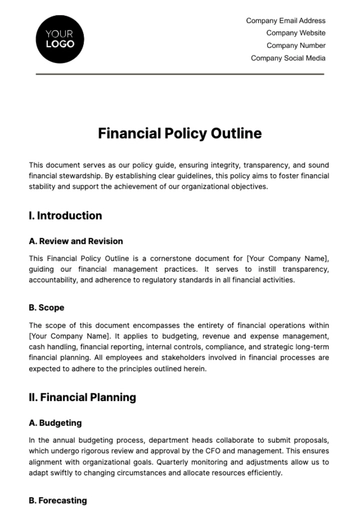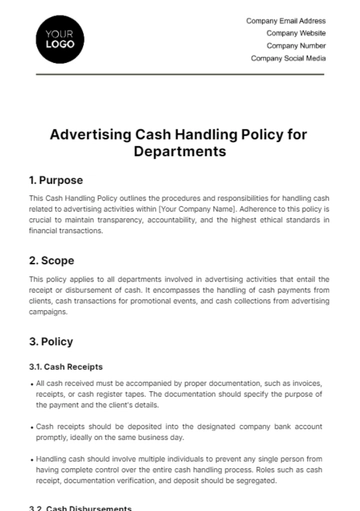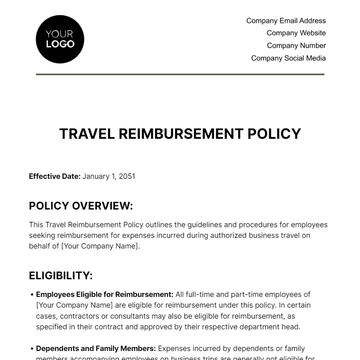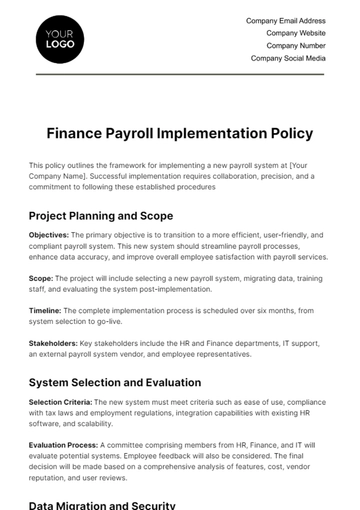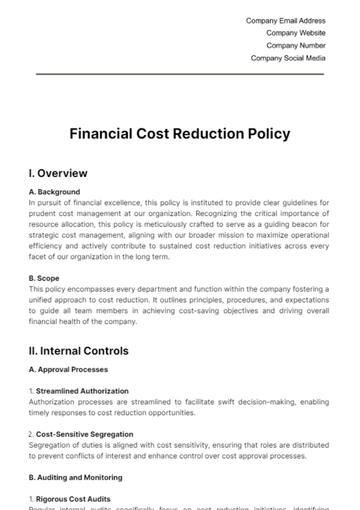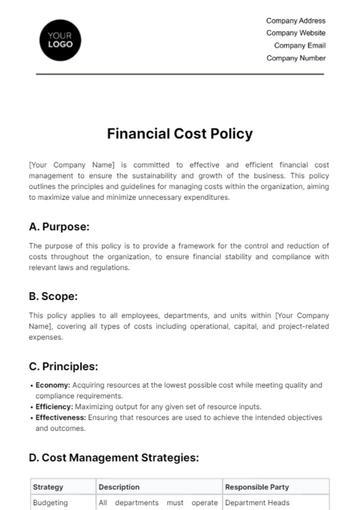Free Financial Policy Outline
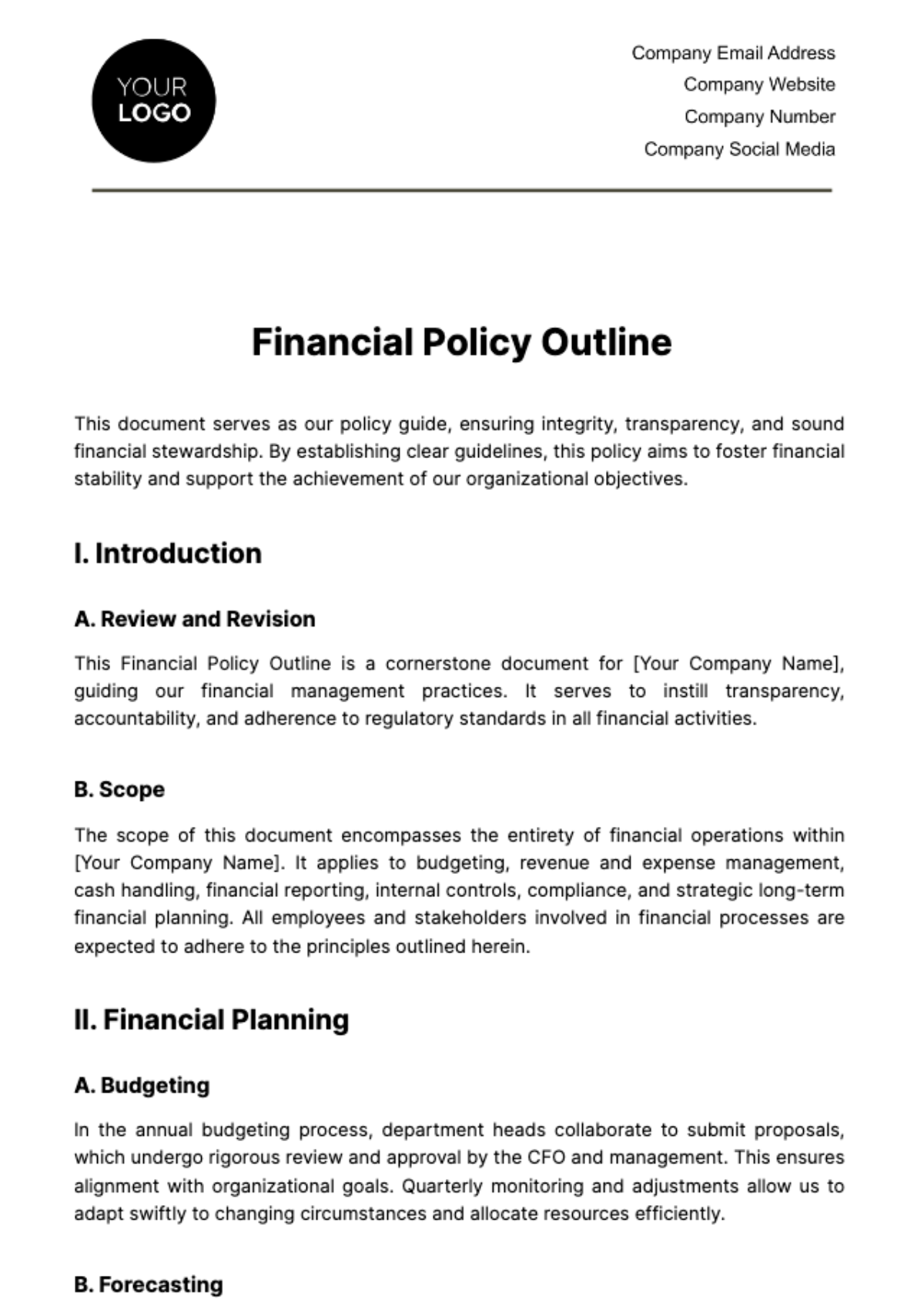
This document serves as our policy guide, ensuring integrity, transparency, and sound financial stewardship. By establishing clear guidelines, this policy aims to foster financial stability and support the achievement of our organizational objectives.
I. Introduction
A. Review and Revision
This Financial Policy Outline is a cornerstone document for [Your Company Name], guiding our financial management practices. It serves to instill transparency, accountability, and adherence to regulatory standards in all financial activities.
B. Scope
The scope of this document encompasses the entirety of financial operations within [Your Company Name]. It applies to budgeting, revenue and expense management, cash handling, financial reporting, internal controls, compliance, and strategic long-term financial planning. All employees and stakeholders involved in financial processes are expected to adhere to the principles outlined herein.
II. Financial Planning
A. Budgeting
In the annual budgeting process, department heads collaborate to submit proposals, which undergo rigorous review and approval by the CFO and management. This ensures alignment with organizational goals. Quarterly monitoring and adjustments allow us to adapt swiftly to changing circumstances and allocate resources efficiently.
B. Forecasting
Financial forecasting, conducted on a regular basis, involves a collaborative effort between the finance department and relevant stakeholders. This proactive approach enables us to anticipate financial trends and challenges, facilitating informed decision-making aligned with our strategic objectives.
C. Long-Term Financial Planning
To ensure our long-term financial sustainability, [Your Company Name] develops and maintains a comprehensive plan that aligns with our strategic goals. This plan considers key financial drivers, such as capital investments and debt management, contributing to our overall financial resilience.
III. Revenue Management
A. Revenue Recognition
We adhere strictly to Generally Accepted Accounting Principles (GAAP) in recognizing and recording revenue. Specific policies govern revenue recognition based on the nature of our diverse revenue streams, promoting accuracy and compliance.
B. Pricing and Discounts
Our pricing strategies are dynamic, responding to market conditions and cost considerations. Approval processes for discounts are in place to maintain profitability while offering flexibility to meet the evolving needs of our customers.
C. Credit Terms
Establishing credit terms for customers, with credit approvals based on predefined criteria, ensures a balanced approach to risk management. Regular monitoring and collection efforts uphold financial discipline while sustaining positive customer relationships.
IV. Expense Management
A. Approval and Reimbursement
Employees are required to obtain pre-approval for expenses, fostering a culture of fiscal responsibility. Expense reimbursement requests, accompanied by proper documentation, undergo prompt processing to maintain efficiency and transparency.
B. Cost Control
Our commitment to cost control involves implementing measures to manage and contain expenses. Rigorous analysis of budget variances allows us to identify opportunities for optimization, ensuring resources are utilized judiciously.
V. Cash Management
A. Cash Handling
Defined procedures for cash handling minimize the risk of errors or fraud in cash receipts and disbursements. Regular reviews of cash flow projections provide insights into liquidity needs, enabling proactive management of our financial resources.
B. Banking Relationships
Maintaining relationships with reputable financial institutions is integral to our financial strategy. Established procedures govern the opening and closing of bank accounts, ensuring compliance and effective banking relationships.
VI. Financial Reporting
A. Internal Reporting
Monthly financial reports, distributed to department heads, provide a basis for performance evaluation and strategic decision-making. Additional internal reporting policies ensure timely and relevant information is available to key stakeholders.
B. External Reporting
Our commitment to preparing financial statements in accordance with accounting standards and regulatory requirements underpins the reliability of our external reporting. Stringent policies guide this process, fostering transparency and compliance.
VII. Compliance
A. Legal and Regulatory Compliance
Our commitment to compliance extends to all relevant laws and regulations. Regular reviews ensure that our policies and practices align with evolving legal standards, promoting ethical conduct in all financial activities.
B. Audits
Periodic internal and external audits are conducted to verify the effectiveness of our financial processes. [Your Company Name] prioritizes cooperation with auditors and the timely resolution of any audit findings, reinforcing our commitment to transparency.
VIII. Investment Policies
A. Investment Strategy
[Your Company Name] adopts an [aggressive/conservative] investment strategy based on our risk tolerance. Investment decisions are aligned with our financial goals, ensuring a prudent approach to wealth management.
B. Investment Evaluation
Clear criteria for evaluating and selecting investment opportunities are established, guiding our approach to managing financial assets effectively. These criteria consider risk, return, and alignment with our overall investment strategy.
IX. Ethical Considerations
A. Code of Conduct
Adherence to a high standard of ethics in financial matters is a fundamental expectation for all [Your Company Name] employees. This commitment extends to policies addressing conflicts of interest, fostering an environment of trust and integrity.
- 100% Customizable, free editor
- Access 1 Million+ Templates, photo’s & graphics
- Download or share as a template
- Click and replace photos, graphics, text, backgrounds
- Resize, crop, AI write & more
- Access advanced editor
Introducing Template.net's Financial Policy Outline Template. This editable and customizable resource, powered by our Ai Editor Tool, assists in crafting comprehensive financial policies tailored to your organization's needs. Ensure clarity, consistency, and compliance with financial regulations. Elevate your financial management with Template.net's innovative solutions.
You may also like
- HR Policy
- Restaurant Policy
- Company Policy
- Accounting Policies and Procedures
- Website Policy
- Privacy Policy
- Safety Policy
- School Policy
- IT and Software Policy
- Law Firm Policy
- Construction Policy
- Interior Design Policy
- Travel Agency Policy
- Education Academic Policy
- Security Policy
- Real Estate Policy
- Expense Policy
- Software Policy



